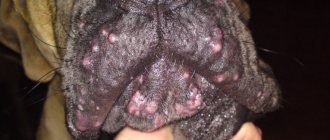Pets bring their owners a lot of pleasant emotions and joy from the time spent together. Unfortunately, all four-legged pets, without exception, can harm household members. Allergies to dogs are one of the most common problems that force people to give up their pet.
Today we will talk about why people are allergic to dogs, how to diagnose this disease, and also tell you whether allergies can be cured and reactions can be stopped temporarily or permanently.
Allergy to dogs
Allergies: why does it appear?
Allergy is a disease that received its name, description of the clinical picture and characteristic symptoms quite recently, about a hundred years ago. However, this disease was known back in Ancient Egypt, although the doctors of that time did not fully understand its causes. All this time, medicine is trying to find the most effective therapeutic regimens that would make the life of allergy sufferers easier.
The search for the “ideal treatment” is due to the fact that an allergy is a negative reaction of the body’s immune system to a substance that seems foreign to it. Therefore, there are thousands of types of allergies, ranging from reactions to dog hair or saliva to allergies to perfumes, plants, foods or medications.
A person can be allergic to thousands of substances
How does an allergic reaction occur? When a “harmful” substance enters the body, regarded by the immune system as foreign, antibodies enter the bloodstream, ready to fight the allergen. A similar process occurs when a person suffers from a real danger, such as an invasion of a virus or infection. If in the case of a disease the body’s reaction is justified, then in the case of allergens there are too many antibodies, and there is no need for them to enter the blood.
However, it has been established that over time the body learns to distinguish between “strangers” and “friends”. This usually happens with infants who are becoming familiar with the world around them. If the baby lives in a house where there are pets or a flower bed outside the windows, then there is a high probability that he will not develop allergies.
Children growing up with dogs are rarely allergic
Causes of allergies
To protect itself from allergenic substances, the body produces antibodies. Production occurs at the moment when the antigens acquire maximum concentration. It is then that a person begins to cough, sneeze, his eyes turn red and other unpleasant symptoms appear. Why do allergies occur?
Medicine distinguishes two types of provoking factors: hereditary and acquired, external. In the first case, the genes of the parents play a role. If the baby’s mother or father is allergic, then with a probability of up to fifty percent he will inherit a predisposition to this disease. If both parents suffer from allergic reactions, the risk of “rewarding” the child with the same problem increases to seventy percent.
There is a high probability that another allergy sufferer will be born into a family of allergy sufferers.
External causes of allergy development are associated with reduced immunity, severe illnesses, especially those that affect the respiratory tract. Also, provoking factors include poor ecology and bad habits - in particular, smoking, which destroys the body.
If we talk about allergies to dogs, then you need to understand that it is not only the animal’s fur that causes a reaction. Much more often, the body resists particles of saliva, dead skin of the pet, skin lubricant, and feces. Also, the cause of allergies is often the food that the dog eats, dust and other “bright” allergens that the dog simply carries on its fur and spreads around it.
Allergens “travel” with the animal
Symptoms of a dog allergy
Each organism is individual, and the clinical manifestations of an allergic reaction may differ from person to person, even if the allergen is the same animal. Usually the signs are combined, and the allergy sufferer exhibits two or three or even more symptoms at the same time.
Table 1. How can allergies manifest themselves?
| Distribution area | Manifestations |
| Skin | Rashes, hives, redness on the skin, in places of contact with animals, peeling, itching. Most often appears on the stomach, neck, groin, elbows |
| Eyes | Lacrimation, redness, conjunctival discomfort, burning, conjunctivitis |
| Airways | Swelling of the mucous membranes, rhinitis, shortness of breath, cough, repeated sneezing, sore throat (as if the inside is very itchy), wheezing, difficulty breathing |
| Ears | Hearing loss, pain, feeling of vacuum and fullness (associated with a decrease in the drainage ability of the organ) |
| Oral cavity | Itching, swelling, damage to mucous membranes |
| The cardiovascular system | Increased heart rate, increased pulse rate, coronary syndrome |
Hives - allergic reaction
Symptoms and signs of allergies in dogs
In dogs, the most common symptom associated with allergies is itchy skin, either localized (in one area) or generalized (over the entire body). In some cases, signs of an allergy include respiratory problems with coughing, sneezing and/or wheezing. Sometimes there may be a thin discharge from the eyes or nose. In other cases, allergic symptoms affect the digestive system, leading to vomiting and diarrhea.
Symptoms and signs of allergies in dogs
Allergy symptoms in dogs:
- Itching
- Hives
- Swelling of the face, ears, lips, eyelids, or ear tips
- Red or inflamed skin
- Diarrhea
- Vomit
- Sneezing
- Itchy ears
- Chronic ear infections
- Itchy eyes
- Constant licking
Diagnosis of allergies
Even if characteristic symptoms appear in a person after interacting with a dog, it is not at all necessary that the person is allergic to the animal. An allergy sufferer who experiences a runny nose, a sore throat or itchy eyes when a dog appears, is in a hurry to “blame” their four-legged friend for this. This may be partly true, but there are nuances.
Firstly, an allergy can occur to a person who has interacted with a dog, but it is associated with pollen or plant spores carried by the animal, microparticles of food eaten by the dog, shampoo or other cosmetics used to care for the pet. Secondly, allergies do not always manifest themselves immediately - due to the accumulation of antigen in the blood, the reaction may be delayed. It turns out that an allergic person will react to the dog, forgetting that an hour ago he was walking in a flowery park. An allergy can also strike a person who communicates with a dog owner or is in a car or a room where the animal was previously located.
Before making a diagnosis yourself, you need to diagnose the cause of the allergy.
Accordingly, symptoms appear, but it is difficult to understand what they are connected with. In these cases, it is necessary to pay a visit to an allergist and visit a special laboratory where tests are done in order to find out with greater accuracy what triggers the allergy.
Skin tests
A simple and common method in Russian clinics for identifying the exact type of allergen that torments a person is skin testing. To undergo this research method, you need to visit an allergist who will prepare different types of allergens (in powder or liquid form). Then the patient's skin is lightly scratched to apply the allergen to the affected area, or the allergen is injected subcutaneously with an insulin syringe.
If a particular antigen causes a reaction in a person, it will appear within half an hour. Symptoms can vary from mild redness to severe swelling and bright hives. However, the method has complications that can be very dangerous.
Sample process
Some especially sensitive allergy sufferers experience a dangerous condition called “delayed-type hypersensitivity.” This means that the reaction can occur six to ten hours after the test and provoke dangerous symptoms, including angioedema. A person should remember this and be ready to seek medical help at any time.
Emergency care for Quincke's edema
Determination of IdE level
A more modern and complex diagnostic method, during which it is determined how much E-immunoglobulin is produced in response to a specific allergen entering the body. The initial check is carried out within the framework of test kits - they usually include common types of allergens: “Animals”, “Fruits”, “Herbs” and the like. If the reaction to any group is confirmed, a narrower and more precise analysis is carried out.
Immunoglobulins type "E" in the blood
Note that a healthy adult who does not suffer from allergies feels good when the amount of total E-immunoglobulin in the blood does not exceed 50 milligrams per liter of blood.
Table 2. Classification of E-immunoglobulin reaction to allergens
| Age groups | Reaction |
| Adults and teenagers over 16 years of age |
|
| Junior schoolchildren | The norm is 90 units, an excess indicates an allergic reaction |
| Preschoolers | The norm is 60 units, an excess indicates an allergic reaction |
| Infants (up to one year) | The norm is 15 units, an excess indicates an allergic reaction |
In children, E-immunoglobulin levels are less stable and depend on age
Other methods for detecting allergies to dogs
In order to learn more about the type of allergy and identify the provocateur with absolute certainty, you can undergo other types of testing.
Table 3. Tests that detect allergies to dogs
| Study | How is it carried out? |
| General blood analysis | The healthcare professional will evaluate the levels of eosinophils and white blood cells in the blood, which indicate an obvious allergic reaction. It is worth starting the examination with this analysis. |
| Blood chemistry | Indicates whether levels of C-reactive protein and immune complexes are elevated in the blood. Allows you to immediately track concomitant diseases, excess or deficiency of any substances |
| General urine analysis | Like a general blood test, it shows an increase in protein complexes, leukocytes and eosinophils. Convenient for first-stage studies in young children, as it does not cause them any discomfort |
| Provocation | A microscopic dose of the allergen is placed under the tongue or on the lining of the person’s nose. The reaction usually appears within a few minutes |
| Tests "Patch" | Adhesive stickers are fixed to the human skin, with the allergen applied to the inside. Stickers are worn throughout the day |
| Immunogram | A certain amount of blood is collected from a human vein, with which tests are carried out in a laboratory setting, adding allergens to it. One of the safest types of research for the patient |
| T-lymphocyte detection test | The person is given a dose of the allergen, then blood is drawn. If an allergy is present, the level of T-lymphocytes in the blood increases |
Drawing blood for testing
It is important to understand that provoking tests, as well as those in which the allergen is introduced directly into the body, are contraindicated in infants, elderly patients, and pregnant women. Also, distorted results and harm to health may occur in people undergoing hormone treatment.
Direct “aggressive” tests should only be carried out in equipped clinics that have an intensive care unit or intensive care unit. The fact is that allergies can manifest themselves as Quincke's edema, anaphylactic shock, as well as edema of the lungs and brain, which can lead to death.
Intensive care unit: general view
Child allergy test
In children of any age, the same methods of research and identification of allergy-provoking factors are used as in adults. The only thing you need to understand is that a child’s delicate body reacts more acutely to irritants, so allergy tests should be carried out as safely as possible for the baby.
Most often, urine and blood tests are taken from children to determine elevated levels of white blood cells, protein compounds and eosinophils. If the blood sample shows an increase in key positions, blood is taken from the child from a vein to conduct research in the laboratory. However, skin tests are also performed in children.
Blood sampling for research
Of course, tests that involve direct contact of the allergen with the child’s body are more gentle than those for adults. Depending on the age of the child, solutions or powders with allergens are mixed in weak proportions. But, despite all the precautions, before the tests you need to visit a pediatrician so that he can first examine the baby and rule out concomitant diseases or illnesses that can give the same symptoms as allergies.
Allergy tests are not performed for children who have recently had infections (flu, ARVI, bronchitis, etc.), as well as for children taking corticosteroids or who have received antihistamines. Tests are also not performed on children under five years of age, since the immune system is in the process of development and does not produce an adequate response. It makes no sense to test infants, since the body’s defenses act chaotically, regardless of the real danger, and the total E-immunoglobulin level is extremely unstable.
Direct allergy tests are suitable for older children
Diagnostics
If you have an allergy, your doctor will do skin tests to determine the cause of your allergic reaction.
Has your baby experienced the first symptoms? Then you urgently need to consult a doctor. This is important for newborns, because... their immunity is not fully formed. When contacting a specialist, the patient is referred for diagnostics. Several methods are used for this:
- Radioallergosorbent test. To carry this out, the child's blood is taken for analysis. With its help, it is determined which allergen there is a reaction to.
- Skin testing is a popular method. In newborns and older children, it is performed on the forearm. A small area of skin is treated with a special solution. Next, scratches are made on it. The allergen is applied to the skin and the reaction is observed. If it is present, then redness and swelling appear in the affected area. A child can be given no more than 15 tests at a time.
If an allergy to dogs is detected, the doctor will prescribe effective therapy.
How to properly prepare for an allergy test?
Tests for an allergic reaction, like many other medical procedures, require certain preparation from the person. This is necessary to more accurately identify the problem and eliminate unreliable or blurred results.
A person visiting an allergist must exclude the presence of allergy-provoking factors and foreign allergens. So, if the road to the hospital runs through a flowering park, you need to wear a medical mask or try to arrive for the appointment in a car with the windows closed. The situation is similar with other antigens.
The patient is responsible for the purity of the allergy test
In order for the data received from an allergist to be as accurate as possible, a person must:
- A few days before your appointment, avoid physical activity and avoid stress and overexertion.
- Stop taking medications and dietary supplements, if possible; otherwise, you should inform your doctor about taking pharmaceuticals.
- Stop eating any food 10-12 hours in advance, that is, the analysis will be carried out on an empty stomach (you are allowed to drink clean water from proven sources, preferably bottled).
- For three days, avoid taking any alcoholic beverages; smokers should smoke their last cigarette no later than one day before the intake.
- For three days, stop eating foods with a high allergy index (honey, chocolate, nuts, citrus fruits, eggs, berries, milk).
You must come to your appointment in a state of complete health. Even a minor illness can distort the results of allergy tests, so from the moment of recovery they wait three to five days and only then pay a visit to the hospital.
Products that most often provoke allergies
What to do if a dog allergy is confirmed?
A person who has been diagnosed with an allergy to a dog makes his own decision about further actions. It’s easiest for people who don’t have their own pet - they just need to minimize contact with animals, not come to visit friends who have tailed pets, and if a meeting is inevitable, they can take antihistamines in advance and then put on a respirator.
If the owner of a dog or someone in the household has acquired an unpleasant illness, there are two options: either you need to part with the pet, or you need to learn to coexist side by side, minimizing the symptoms of allergies.
Many owners do not agree to give up their dog under any circumstances.
If a person is not ready to part with his pet, he should take preventive measures aimed at alleviating his own condition. What to do in this case?
- Pay attention to daily wet cleaning of the room: dusting, vacuuming, sweeping the floors. It is recommended to install an air purifier that filters even the smallest allergen particles.
- Get rid of items that hold allergens: heavy curtains, upholstered furniture with voluminous covers, carpets, bedspreads with folds, etc.
- Change bed linen weekly, washing it with hypoallergenic products.
- Ventilate living rooms, constantly check that fresh air enters the room.
- Limit the dog’s movements: do not allow the pet into the kitchen (or any other room where the allergic person eats), and also strictly prohibit the pet from getting on the bed.
- Do not allow your dog to lick a person with allergies. In turn, an allergy sufferer should reduce contact with the animal; if this is not possible, use a respirator mask (for example, when washing a dog) and protective gloves (for example, when playing with a ball or a stick on a walk, so that saliva does not get on exposed skin) .
Along with the toy, the dog will also pass on allergens to the owner.
It is also important to regularly carry out hygiene measures for the dog itself and be attentive to its contents. The pet must be vaccinated and treated quarterly for helminths. If the dog is unwell, you need to show it to a veterinarian and follow all his instructions, since a sick animal has a weakened immune system and becomes even more allergenic to humans.
The dog needs to be washed more often, using special hypoallergenic cosmetics for animals. If the breed has long hair, you need to instruct a loved one who does not suffer from allergies to thoroughly comb the dog every two to three days. If funds allow, it is better to take the dog to a groomer, who will quickly and effectively rid the dog of the fallen undercoat and also give him a shorter haircut.
The help of a groomer is invaluable during periods of animal shedding.
Important point! Despite the assurances of unscrupulous puppy sellers, there are no hypoallergenic dog breeds. Yes, there are less allergenic breeds due to the lack of wool or its special structure, but a person reacts not only to wool. There are no dogs that do not salivate, have skin, or perform toilet routines.
Allergy prevention
The health of a pet depends entirely on its owner. To prevent allergies, it is necessary to carefully select food for the dog, prevent helminthic infestations, cleanse the intestines of toxins, take measures to increase the dog’s immunity, use only hypoallergenic products to care for the dog, regularly examine the dog, and prevent tick bites.
Frequent walks in the fresh air, active games, and properly selected feeding will also help strengthen your pet's immunity.
How to treat dog allergies?
The best results are obtained, of course, by completely eliminating allergens. Reducing the antigen dose is a reliable and effective method that does not have any contraindications, restrictions or negative side effects. All allergy sufferers, no exceptions, are advised to purchase a high-quality air purifying complex. Modern air humidifiers operate silently and almost completely destroy bacteria, harmful bacteria and allergens. Their only drawback is their high cost.
An air humidifier almost completely cleans the room of allergens
Treatment of allergies with medications is very limited, since drugs generally do not stop an allergic attack, but only relieve symptoms to one degree or another. Also, for allergy sufferers, enterosorbents are used to remove harmful substances from the body.
Thus, antihistamines, including cortisone, theophylline, ketotifen and the like, block allergy mediators and prevent the activation of antibodies produced in response to invading antigens. In fact, this is not a treatment for allergies, but only a reduction in symptoms. Such drugs are used as first aid during an acute attack; often allergy sufferers with severe manifestations of the disease even carry syringes with a dose of the drug.
The most effective way to relieve allergy symptoms is by injection.
At the moment, a medicine is being developed that can instantly block an acute allergic attack. Doctors have already discovered a mechanism for interrupting the production of antibodies (action in one second); for this purpose, a special protein macromolecule has been created that stops the body’s immune response. Now this method is experimental, but on its basis it is planned to refine existing allergy drugs and create new ones.
There is also a method for treating allergies, based on the patient undergoing a course of injections with small doses of histamine, which increase with therapy. Doctors believe that this way the body reduces its susceptibility to allergic reactions, as it gets used to the flow of histamine and becomes resistant to this substance.
The dose of histamine is selected individually, based on a blood test
Another step familiar to every allergy sufferer is taking standard pharmaceutical medications aimed at mitigating or even completely eliminating allergy symptoms. If the attacks do not cause severe discomfort, a person can easily cope with them by purchasing an appropriate over-the-counter remedy at the pharmacy. Combining two medications, such as a nasal spray and tablets, is effective. Despite the harmlessness of such products, you need to obtain the approval of an allergist before purchasing them.
Table 4. Drugs that facilitate the relief of an allergic attack
| Name | Action Information | approximate cost |
"Suprastin" | Helps relieve skin itching and swelling of mucous membranes. Minimally absorbed into the bloodstream. May cause drowsiness | About 180 rubles |
"Tavegil" | Effective against rhinitis, urticaria, itchy skin | About 130 rubles |
"Fenistil" | Relieves allergy symptoms, has a prolonged effect, and has minimal side effects | About 350 rubles |
"Telfast" | A safe drug that relieves allergy symptoms well, without affecting the nervous system, that is, it does not cause drowsiness or inhibited reactions. | About 500 rubles |
"Citirizine" | Effective primarily against skin rashes, redness, urticaria spots | About 120 rubles |
"Erius" | Blocks receptors that are influenced by histamine, due to this the allergy attack is stopped quickly and for a long time | About 600 rubles |
"Zyrtec" | A long-acting drug that suppresses allergy symptoms for up to a day | About 250 rubles |
Important point! Allergy treatment should not be left to chance, using available remedies that relieve symptoms. To prevent allergies from progressing and poisoning a person’s life even more, it is better to consult an allergist, undergo the necessary tests and identify what the body is reacting negatively to.
Perhaps the solution to the problem lies on the surface, and the dog is not at all to blame for the owner’s torment. The results of an allergy test may show that the owner only needs to change the brand of dry food or walk the pet away from flowering plants for the annoying allergy symptoms to subside.
Don't let allergies take their course
Let's summarize
Many people love animals very much, in particular dogs, and dream of such a pet. Unfortunately, allergy symptoms do not always allow you to enjoy communication with animals, as they cause real physical discomfort for a person. The situation is especially sad if the allergy appears unexpectedly, when the dog already lives in the family and is a dear friend for the household.
In any case, you first need to obtain medical confirmation that it is the four-legged pet that provokes the unpleasant reactions. After the diagnosis has been carried out, a person must make a decision - either enjoy communicating with the dog, as before, relying on modern methods of treatment and symptom relief, or get rid of the source of the allergy.
How to choose a hypoallergenic pet
Numerous studies have confirmed the existence of hypoallergenic dog breeds (dogs that do not cause allergies) that rarely cause symptoms of the disease in people prone to it. First of all, their peculiarity is associated with less molting, during which the allergen spreads abundantly. In addition, dogs whose salivary fluid contains low levels of the protein that causes allergy symptoms are less likely to cause allergies. And, of course, representatives of “slobbery” breeds are not suitable for an owner with allergies.
But among other things, it should be borne in mind that hypoallergenic breeds can still cause the disease in certain people. There have also been cases in medicine where two dogs of the same breed had different effects on human health. One dog provoked an exacerbation of allergies, while the second did not cause such a negative reaction.
Since it is impossible to know in advance whether a pet will provoke an exacerbation of the disease in an allergy sufferer, it is necessary for the person to stay with the dog for some time before a new member appears in the family. And if the body does not react in any way to the proximity of a four-legged friend, you can think about taking the dog into the house.
If this is not possible, then you need to agree in advance with the breeder about the likelihood of returning the puppy back if its presence in the home affects the health of anyone in the family. When choosing a hypoallergenic dog, you need to consider some points:
- It is worth giving preference to dogs that shed less. There is an opinion that animals with long fur cause a strong allergic reaction, however, this is not so. The risks of exacerbation of the disease are higher if there is a dog with short hair in the home that sheds constantly. In addition, cleaning short hairs is a rather difficult and sometimes impossible task. In a house where an allergy sufferer lives, it is better to take a modest-sized dog, since less hair will be separated from it than from a large animal.
- “Loud” pets are more likely to cause allergies. This observation is associated with the fact that when a dog barks a lot, it produces a lot of saliva containing allergens.











